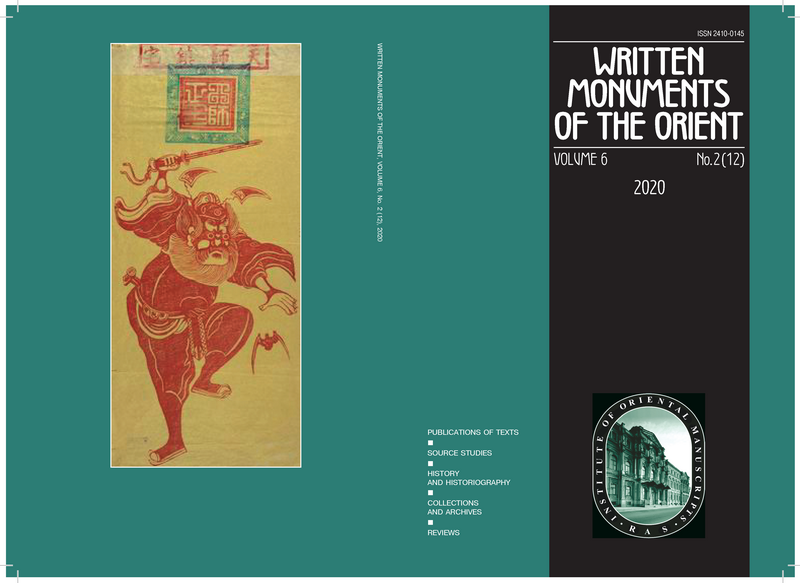SI 4904: Сonservation as a Base for New Discoveries
- Авторы: Korosteleva K.V.1
-
Учреждения:
- Laboratory Serindica of the Oriental Manuscripts, Russian Academy of Sciences
- Выпуск: Том 6, № 2 (2020)
- Страницы: 114-119
- Раздел: Original Papers
- Статья опубликована: 09.02.2021
- URL: https://journals.eco-vector.com/2410-0145/article/view/49894
- DOI: https://doi.org/10.17816/wmo49894
- ID: 49894
Цитировать
Полный текст
Аннотация
Book fragments in Old Uyghur language, that constitute the major part of the Serindia collection, currently undergo conservation and preservation procedures. The throughout conservation started in 2019 showed, that modern methods not only give new life to ancient texts, but also contribute to the academic research. The article sought to describe conservation procedures of the particular fragment SI 4904 from the Serindia collection, as well as subsequently made discoveries.
Полный текст
Until recently, SI 4904 (old call number: K/20) was just one of more than four thousand fragments in Old Uyghur language kept in the Serindia collection of the IOM, RAS. The fragment belongs to the sub-collection of Aleksander Ivanovich Kokhanovsky, doctor of the consulate in Urumchi from 1903 to 1906 and head of the Turfan expedition in 1906–1907. 1 A. I. Kokhanovsky acquired manuscript fragments from the local people, therefore their exact provenance is unknown. His sub-collection includes 520 items, 34 of which are fragments in the Old Uyghur language. The majority of them are of small size and contain Buddhist texts. SI 4904 was considered to be of special interest as it had a fragment of a coloured image on recto side.
In the inventory book, compiled in 1929–1930 by S.F. Oldenburg, this item was described as “a fragment of the partially preserved image with Mongolian texts on the reverse, Turfan”.2 Registered in the modern inventory book as “several manuscript fragments pasted together”, SI 4904 was passed to Conservation laboratory in June, 2019. During the preliminary examination it became obvious, that the layers of paper were glued together uniformly and were most probably pasted together on purpose to form a hardened base for the image. As reading and identification of the texts was almost impossible without disjointing, it was decided to separate the layers for further study.
For this purpose, we conducted the analysis of the fragment, and the microscopic examination revealed that the image (SI 4904 recto) was produced with the use of adhesive mineral dyes on a primed paper. Supposedly, the range of used pigments includes red lead (red colour), indigo (dark
blue colour), azurite (blue colour), gamboge with indigo (light green colour, virtually flat layer). White primer is visible on the edges of the image (its composition can be established only by a chemical analysis). Сontour lines of dark grey colour found in places of primer and paint loss indicate that a thin uneven layer of primer was applied to create a uniform surface. After drawing the outline, it protected the paper from absorption of paint binder and provided color intensity.
On the miniature one can see a buddha sitting in padmāsana on a lotus-throne with light blue and red petals. Preserved parts of the dhotī garment are decorated with geometrical ornament. Parts of mandorla of green hue and light halo are also visible. The absence of specific attributes and fragmentarity of the image (loss of colourful layer in the central part of the fragment) makes it impossible to identify the buddha.
Due to the multiple delaminations, losses and abrasion of the primer and paint layers, it was obvious that the conservation procedures aimed to preserve the image and fragments of manuscripts and block prints, used for hardening its base, should be conducted with great care. Firstly, dyes and ink underwent water resistance tests. It turned out that all of them were not water resistant and they were fixed with a 2% solution of Klucel to avoid blurring during conservation procedures. The edges of losses and paint layer cracks were glued by a 5% wheat starch paste to exclude further destruction. It was decided to gradually separate paper layers on the reverse side of the image, therefore the entire surface of the paint layer was fixed with the use of equally strong paper with methylcellulose (MH 300p) solution. Separation was carried out in two stages. At first, the layers of pasted paper were evenly moistened through the filter paper. Then the fragments of manuscripts and block prints were separated entirely with tweezers and a scalpel. Thick layers of dark brown glue were removed, while the residues (impossible to be extracted without damage) that penetrated deep into the paper structure were left. Tears were reinforced with the Japanese conservation paper (Awagami Papers, Shunyo SH-1, 19 g/m2).
As a result, six separate fragments were extracted, five in Old Uyghur script and one in Chinese. The reverse of the coloured image appeared to be the part of a Chinese scroll, its text corresponds to Taishō Tripiṭaka # 211 (04.0590b01–19) with some variants.
One manuscript fragment of larger size (in calligraphic script on recto and cursive on verso side) and two, extremely small (severely damaged, text is illegible), include a part of the colophon to a prestigious Buddhist edition (according to the names of initiators mentioned).
Two fragments used to be parts of block prints. One of them includes only two incomplete lines of dhāraṇī. The other, fragment of the block print edition of Sitatāpatrādhāraṇī sūtra, allows to speculate on the date when the fragments were pasted: one can suppose that the image could not be produced earlier that the second half of the 13th century.
Thus, the conducted conservation procedures allowed to obtain unique Chinese and Old Uyghur texts that require further research. However, the function of the image still remains obscure. One may assume, although with a dose of skepticism, that it used to be a part of the deluxe Buddhist book cover.
Об авторах
Kristina Korosteleva
Laboratory Serindica of the Oriental Manuscripts, Russian Academy of Sciences
Автор, ответственный за переписку.
Email: christian159@mail.ru
Россия
Дополнительные файлы








